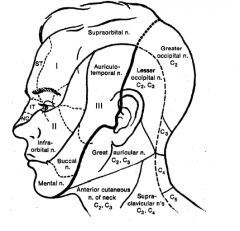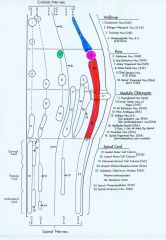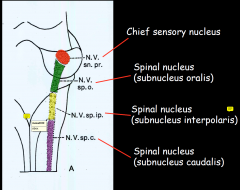![]()
![]()
![]()
Use LEFT and RIGHT arrow keys to navigate between flashcards;
Use UP and DOWN arrow keys to flip the card;
H to show hint;
A reads text to speech;
12 Cards in this Set
- Front
- Back
|
Trigeminal Nerve
|
sensory to face and supratentorial structures (all exceot the conchae of the auricle which is VII, IX, X)
|
|
|
Trigeminal Nerve Facts
|
(a) Sensory nerve of the face and supratentorial
structures (b) Contains “somatic afferent” fibres (c) Some “special visceral efferent” fibres to muscles of mastication (d) Supplies the first branchial arch and innervates structures derived from this region (e) Leaves the pons laterally (f) Has a small medial motor root and a large lateral sensory root (g) Cell bodies of the sensory nerve found in the “semi-lunar” or “gasserian” ganglion AND the “mesencephalic nucleus of V” (MESENC. only ganglion not outside the CNS) (h) Three branches leave the ganglion Opthalmic (Vi), Maxilliary (Vii) and Mandibular (Viii) |
|
|
Dermatomes of the head and neck
|

|
|
|
Brainstem Nuclei
|

|
|
|
Trigemenial Complex
|

|
|
|
Ventral Trigeminothalamic tract
|
Information relayed in this nucleus then
passes to the THALAMUS via a contralaterally projecting tract cross to join the medial leminiscal pathways - at the level of the pontone mescencephalic part (thus not until above the level of the pons is the whole body represented in the ML |
|
|
Vmes
|
(a) Nucleus located on the floor of the 4th ventricle between the pons and the midbrain rostral to the entry point of the trigeminal nerve
(b) Receives inputs from proprioceptors in the TMJ and the muscles of mastication. (c) Nucleus is unusual in that it is made up of primary afferent cell bodies (d) Information relayed via this nucleus then passes to • the motor nucleus of the trigeminal (bilaterally) • the thalamus (ventro-posterior nucleus: VPM) it can therefore acutally drive muscles its recieving from (important for co-ordinated chewing) |
|
|
Cheif Sensory Nucleus of trigmeninal
|
(a) Nucleus located in the rostral pons, at the entry point of the trigeminal nerve
(b) Receives thick myelinated input fibres with information from low threshold mechanoreceptors of the orofacial region. (c) Inputs maintain a strict ordered topography (d) Information relayed in this nucleus then passes to the THALAMUS via a contralaterally projecting tract called the VENTRAL TRIGEMINOTHALAMIC TRACT. |
|
|
Spinal Nucleus of the Trigeminal
|
(a) Nucleus located along the rostro-caudal extent of the caudal pons and medulla.
(b) Receives inputs from lightly and unmyelinated fibres of the trigeminal nerve. (c) Resembles dorsal horn of spinal cord in cytoarchitecture (d) Runs in parallel with the spinal tract of the trigeminal nerve just below the lateral edge of the medulla (e) Spinal tract of trigeminal contains also fibres from the vagus and the glossopharyngeal nerves which will synapse in the spinal nucleus. (f) Receives information from low threshold mechanoreceptors, thermoceptors and nociceptors from the entire region of the head. (g) Information relayed in this nucleus then passes to the venteroposterior nucleus of the thalamus via the contralaterally projecting ventral trigeminothalamic tract HARD DD b/w V and C1 at the spinal level |
|
|
Trigeminal Fibres organisation
|
Fibres from the mandibular division (Viii) travel in the
uppermost sector (dorsal). Fibres from the opthalmic division (Vi) travel in the lowest sector (ventral). The fibres from the maxilliary division travel in between - they synpase so the nose tip is first then circles towards the dorsal crown of the head |
|
|
Potential neck pain referal
|
Fibres from the ophthalmic division (Vi) travel the longest distance and some may “forget” to synapse in the spinal nucleus of the trigeminal and end up synapsing in the upper segments of the spinal cord (C1-C3) where they converge with signals coming from deep neck muscles.
|
|
|
Reflexes Involving the Trigeminal
Complex |
(a) Corneal Reflex:
The blink reflex arc depends on trigeminal fibres (b) Sneeze Reflex Elicited by stimulation of the mucous membranes of the nasal cavity (c) Suckling or Rooting Reflex Elicited in new-borns from the mechanoreceptors of the lips (d) Masseter Reflex A sharp tap on the jaw causes the mouth to close. This is a simple stretch reflex similar to the knee jerk reflex in the spinal cord. The cell bodies of muscle spindle afferents of the masseter are found in the mesencephalic nucleus of the trigeminal, the centrally directed processes synapse in the motor nucleus of the trigeminal. |

